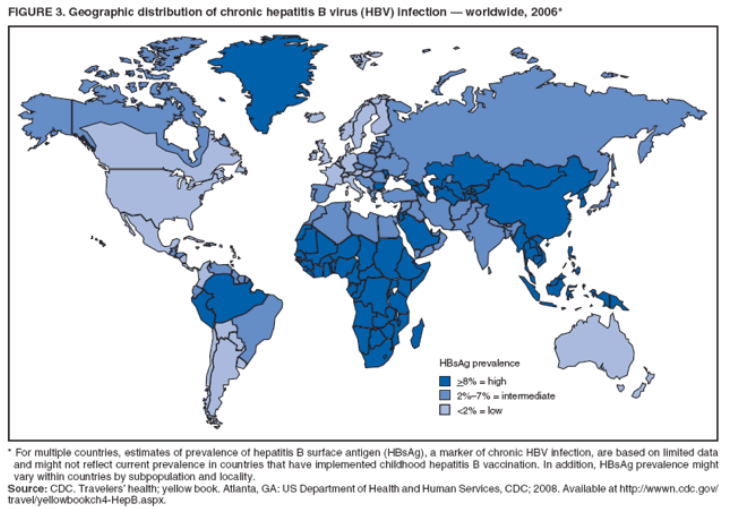Hepatitis B epidemiology and demographics
|
Hepatitis B |
|
Diagnosis |
|
Treatment |
|
Case Studies |
|
Hepatitis B epidemiology and demographics On the Web |
|
American Roentgen Ray Society Images of Hepatitis B epidemiology and demographics |
|
Risk calculators and risk factors for Hepatitis B epidemiology and demographics |
Editor-In-Chief: C. Michael Gibson, M.S., M.D. [2]
Overview
Chronic Hepatitis B (HBV) is a major global health problem. According to the World Health Organization (WHO), more than 2 billion people have been infected with HBV. It is a major cause of chronic liver disease worldwide, affecting an estimated 1.25 million persons in the U.S., and more than 240 million people world wide.[1] [2]
Incidence and Prevalence
An estimated one third of the global population has been infected with HBV, and more than 780,000 people die every year from related acute and chronic consequences. Regions with the highest prevalence of HBV include sub-Saharan Africa and East Asia. The infection is usually acquired during childhood in these regions. Approximately 5-10% of adults are chronically infected. Higher rates of chronic HBV is also found in southern parts of Eastern and Central Europe, the Amazon, the Middle East, and India. An estimated 2-5% of the population in the Middle East and Indian subcontinent is chronically infected.

In 2009, there were 38,000 acute HBV cases reported in the U.S. This was the lowest incidence ever recorded at 1.5 cases per 100,000 population. Between 1991 and 2010, the incidence of HBV has decreased by approximately 82%. The decrease was greatest among children largely due to implementation of routine vaccination in 1991. Since 2001, fewer than 30 cases of acute HBV have been reported annually among children born in 1991 or later, the majority of whom were international adoptees or children born outside of the U.S who were not fully vaccinated.()
Although the incidence of HBV is declining in the U.S., it is important to note that reported cases underestimate the true incidence of HBV infection due to the asymptomatic nature of early infections and because of under reporting of symptomatic cases.
Chronic HBV affects an estimated 800,000 - 1.4 million persons in the U.S. and is responsible for approximately 3,000 annual deaths from associated chronic liver disease. 47%-70% of U.S. residents with chronic HBV were born in other countries. While the prevalence of chronic HBV infection among younger, vaccinated foreign-born U.S residents is decreasing, the rate of liver cancer deaths continues to be high among certain foreign-born U.S. populations. The rate of liver cancer deaths is highest among Asian/Pacific Islanders, reflecting the high prevalence of chronic HBV in this population.

References
- ↑ World Health Organization. 2014 Fact Sheet. Hepatitis B. http://www.who.int/mediacentre/factsheets/fs204/en/
- ↑ Center for Disease Control and Prevention. Guidelines for Hepatitis Sureveillance and Case Management 2009.http://www.cdc.gov/hepatitis/Statistics/SurveillanceGuidelines.htm